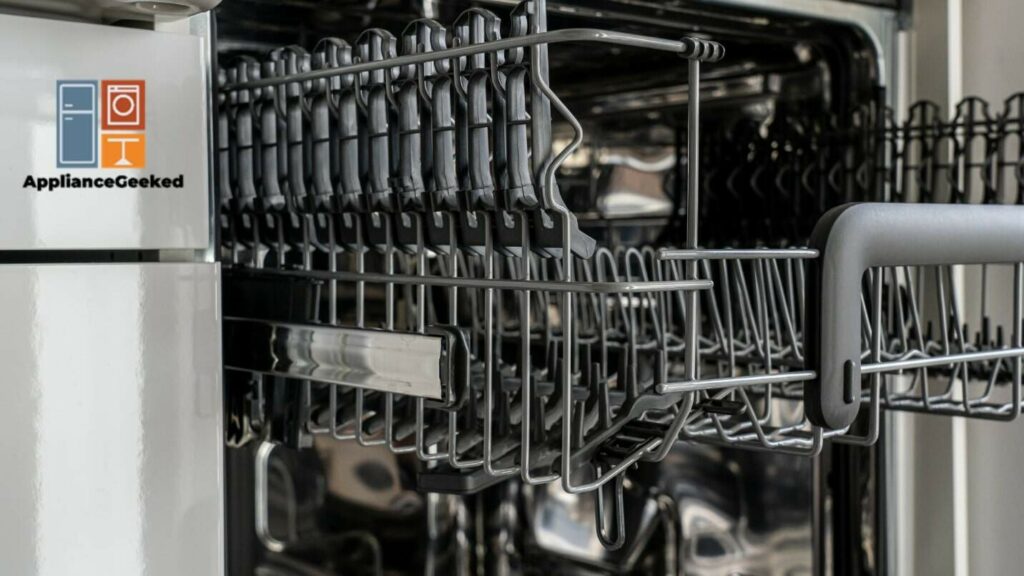
Forget about monsters in the closet! As a tired and often sleep-deprived adult, finding a load full of dirty dishes at the end of a wash cycle is a nightmare we never want to experience, especially if our post-meal plans for some R&R are on the line.
So you can enjoy a well-deserved break after a long day, we’ve made a little guide to help you understand why your GE dishwasher dispenser isn’t opening. We also provide step-by-step repair instructions so you can get the dishes done in no time.
Why is my GE dishwasher soap dispenser not opening?
A GE dishwasher soap dispenser won’t open if it’s blocked by dishes or detergent residue. If you don’t load the dishes properly, you can prevent the dispenser from opening during cycles.
Without routine cleaning, old detergent can clump up around the dispenser and block it.
Here are a few steps that can help you identify the underlying cause of the issue.
- Understand the dispenser design of your dishwasher.
Not all GE soap dispensers are made equal. There are three designs: a sliding cover, a flip cover, and a cover with a handle.
Knowing how the dispenser opens and closes will help you ensure that the cup isn’t stuck, blocked, or defective. For instance, flip covers open against the top rack, which is completely normal.
- Do a quick visual inspection.
Check the dispenser for detergent build-up in and around it. Old detergent can dry up and accumulate, causing the dispenser to get stuck.
If you’ve ruled out detergent build-up as a potential cause, check the racks to confirm that everything is where it’s supposed to be.
Although an obstruction is the most likely cause, there are other issues that can prevent the soap dispenser from opening. Keep reading below to learn more about them.
Causes and Solutions
There are 4 possible reasons why your dishwasher’s soap dispenser won’t open.
- The dispenser is clogged with old, dried-up detergent.
- The dishes are obstructing the dishwasher dispenser.
- The dispenser is overfilled.
- The control board is faulty.
Here’s a quick overview of how to troubleshoot these issues.
| Causes | Solutions |
| The dispenser is clogged with old, dried-up detergent. | • Wipe detergent build-up on the dispenser with a damp cloth. • For dried-up detergent, use a blunt object like a wooden spoon to scrape it off. Then, use a damp cloth to get rid of any residue. |
| The dishes are obstructing the dishwasher dispenser. | • Add the tableware and cookware to the right racks to prevent possible obstructions. • Before running a cycle, confirm that the tall items aren’t touching the soap dispenser. |
| The dispenser is overfilled. | • Break tablet/pod detergent before loading them into the dispenser to prevent the cover from getting clogged. • If you prefer detergent powder, use high-quality and new products. Never use old powdered detergent, especially if it has hardened inside the box. |
| The control board is faulty. | • Unthread the screws mounting the dishwasher to the countertop. Then, pull the dishwasher out. • Spread a towel on the floor and gently lay the unit on its back. • Unthread the screws on the access panel. Then, remove it along with the insulation. • Unfasten the screws on the junction box cover. Remove the cover and disconnect the jumper wire. • Unplug the wiring harness that connects to the control panel. • Unthread the inner screws mounting the control board support panel. Then, pull down the support panel. • Disconnect the wires to release the control board. • Remove the grounding screws and press the mounting pins using pliers to free the old board from the support panel. • Align the new control board on the support panel, push it down, and secure it in place. Connect the wires to the new control board. • Mount the support panel. Plug in the wiring harness and jumper wire. • Realign the junction box cover and replace the screws to mount it in place. Reinstall the insulation and the access panel. |
The dispenser is clogged with old, dried-up detergent.
Ideally, you should wipe off the detergent residue on the dispenser after every wash. Over time, the old detergent can dry up and accumulate, which can clog the dispenser and prevent it from dispensing soap properly.
Solution: First, check for dried-up detergent build-up in and around the dispenser. Open the dispenser cover and wipe any residue with a soft damp cloth.
If the detergent has hardened and won’t come off with a wipe, use a blunt object like a wooden spoon to scrape it off.
The dishes are obstructing the dishwasher dispenser.
Improper loading of dishes can prevent water from reaching the dispenser and dissolving the detergent. At times, large items can also block the dispenser and prevent it from opening during cycles.
Solution: Load your dishes in the correct racks to ensure proper cleaning. Avoid overloading or underloading the dishwasher.
- Upper Rack: Add glasses, bowls, cups, and other small items to the top rack. Place them upside down, facing the spray arm.
- Lower Rack: Load plates, platters, cookware, and other similar items vertically on the bottom rack, allowing water jets to pass through the dinnerware for optimal wash performance.
Large items should go on the sides of the rack. For platters, bowls, and pots, you can also place them on the corners and at the back of the rack.
- Silverware Basket: Add utensils to the silverware basket. Mix the knives, forks, and spoon to avoid nesting.
The dispenser is overfilled.
Whether you’re using tabs, pods, liquid, or powdered detergent, you should never overfill the dispenser. It can cause the cover to get stuck, preventing it from opening during wash cycles.
Solution: Load the dispenser properly with high-quality dishwasher detergent to prevent the cover from getting stuck.
Here are a few tips that might help.
- Tablets/Pods: Break the tablets or pods into smaller pieces to make sure they fit properly. Try to close and open the cover to make sure it isn’t stuck.
- Powder: Refrain from using a powdered detergent that has already hardened in the box. Don’t leave detergent in your dishwasher as it can harden, making it difficult to open the cover manually.
- Liquid: Pour the recommended amount of high-quality detergent into the dispenser so that it can easily be dissolved and dispensed during cycles.
The control board is faulty.
A dishwasher’s soap dispenser has a spring-operated door latch that opens after the tub is filled and the dishes have been rinsed with hot water. The control board signals the dispenser to open during cycles.
If the control board malfunctions, it can cause all sorts of problems. At times, it may prevent the dispenser from doing its job.
Solution: To replace a GE dishwasher main control board, follow these steps carefully:
- Step 1: Unplug the dishwasher and turn off the water supply.
- Step 2: Open the door and unthread the screws mounting the dishwasher to the countertop.
- Step 3: Carefully pull the dishwasher out of the cabinet.
- Step 4: Put a towel down and gently lay the unit on its back.
- Step 5: Unthread the screws on the access panel at the bottom of the dishwasher.
- Step 6: Remove the panel along with the insulation.
- Step 7: Use a 5/16” nut driver to unfasten the screws on the junction box cover. Then, remove the cover and disconnect the jumper wire.
- Step 8: Unplug the wiring harness that connects to the control panel.
- Step 9: Unthread the inner screws mounting the control board support panel.
- Step 10: Pull down the support panel.
- Step 11: Take a photo of the wires on the control board for reference.
- Step 12: Disconnect the wires to release the control board.
- Step 13: Use a 1/4” socket or nut driver to remove the grounding screws.
- Step 14: Press the mounting pins using pliers to free the old board from the support panel.
- Step 15: Align the new control board on the support panel. Then, push it down until it snaps into place.
- Step 16: Secure the grounding screw.
- Step 17: Connect the wires to the new control board. Pull up your photo reference.
- Step 18: Mount the support panel and secure it with its screws.
- Step 19: Plug in the wiring harness that connects to the control panel and the jumper wire.
- Step 20: Realign the junction box cover and replace the screws to mount it in place.
- Step 21: Reinstall the insulation and the access panel.
- Step 22: Keep the dishwasher upright and mount it on the cabinet. Then, plug it in and turn on the water supply.
- Step 23: Check if the dishwasher turns on and runs a cycle.
Frequently Asked Questions
If your soap dispenser has an inconsistent performance, it most likely isn’t a dishwasher error. It could be due to improper loading of dishes or detergent.
You can easily resolve the issue by loading your tableware and cookware in the correct racks. In doing so, you can make sure the door opens properly and that the detergent can fully dissolve during cycles.
Additionally, you should never overfill the dispenser as it may cause the cover to get stuck.
A faulty control board can affect how your dishwasher dispenses detergent during cycles. However, it is a very rare occurrence and often hard to diagnose, which is why you should look into the more common causes before considering this.



